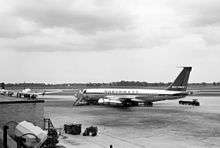Northwest Airlines Flight 705
 N723US, the sister ship of the aircraft involved in the accident, photographed at Detroit Metropolitan Wayne County Airport in July 1962. | |
| Occurrence | |
|---|---|
| Date | February 12, 1963 |
| Summary | Loss of control and in-flight breakup |
| Site |
Everglades, Monroe County, west of Miami, Florida 25°33′53.35″N 80°53′0.27″W / 25.5648194°N 80.8834083°WCoordinates: 25°33′53.35″N 80°53′0.27″W / 25.5648194°N 80.8834083°W |
| Aircraft type | Boeing 720-051B |
| Operator | Northwest Orient Airlines |
| Registration | N724US |
| Flight origin | Miami International Airport, Florida, United States |
| Stopover | O'Hare International Airport, Illinois, United States |
| Destination | Spokane International Airport, Washington, United States |
| Passengers | 35 |
| Crew | 8 |
| Fatalities | 43 |
| Injuries | 0 |
| Survivors | 0 |
Northwest Airlines Flight 705 was a scheduled passenger flight operated on February 12, 1963 which broke up in midair and crashed into the Florida Everglades shortly after take-off from Miami International Airport in a severe thunderstorm. The plane was destined for Portland, Oregon, via Chicago, Spokane and Seattle.
Accident
Prior to departing from Miami, the flight crew questioned the ground controller at the airport about the departure routes being used, and he replied that most flights were departing "either through a southwest climb or a southeast climb and then back over the top of it."[1]
After the Boeing 720 lifted off from runway 27L, helmed by Captain Roy Almquist,[2] it made a left turn based on radar vectors from Miami Departure Control, to avoid areas of anticipated turbulence associated with thunderstorm activity. Another flight had followed the same guidance shortly before the jet took off.
While maintaining 5,000 feet and a heading of 300 degrees, Flight 705 contacted controllers and requested clearance to climb to a higher altitude. After a discussion between the flight and the radar departure controller about the storm activity, and while clearance to climb was being coordinated with the Miami Air Route Traffic Control Center, the flight advised "Ah-h we're in the clear now. We can see it out ahead ... looks pretty bad."
At 13:43, Flight 705 was cleared to climb to flight level 250. They responded, "OK ahhh, we'll make a left turn about thirty degrees here and climb..." The controller asked if 270 degrees was their selected climbout heading, and they replied that this would take them "... out in the open again..." Controllers accordingly granted the jet clearance. Following some discussion about the severity of the turbulence, which was described as moderate to heavy, the flight advised, "OK, you better run the rest of them off the other way then."
At 13:45, control of Flight 705 was transferred to Miami Air Route Traffic Control Center. There were communication difficulties, although after the jet was provided with a different frequency to tune to, the flight crew established contact with Miami ARTCC. Several minutes after contact was established, the jet's altitude began increasing with a rate of climb gradually increasing to approximately 9,000 feet per minute. Following this rapid ascent the rate of climb decreased through zero when the altitude peaked momentarily at just above 19,000 feet. During this time the jet's airspeed decreased from 270 to 215 knots and as the peak altitude was approached, the vertical accelerations changed rapidly from 1G to about -2G.
In the next seven seconds the negative acceleration continued to increase at a slower rate, with several fluctuations, to a mean value of about -2.8G, the jet began diving towards the ground with increasing rapidity. As the descent continued with rapidly increasing airspeed, the acceleration trace went from the high negative peak to 1.5G, where it reversed again.
Below 10,000 feet the forward fuselage broke up due to the forces of the dive. The main failures in both wings and horizontal stabilizers were in a downward direction, and virtually symmetrical. The forward fuselage broke upward and the vertical stabilizer failed to the left. All four engines generally separated before the debris of the aircraft fell in unpopulated area of the Everglades National Park, 37 miles west-southwest of Miami International Airport.
Investigation
The final report on the crash determined the cause of the accident to be the unfavourable interaction of severe vertical air drafts and large longitudinal control displacements, resulting in a longitudinal upset from which a successful recovery was not made.
References
- ↑ Civil Aeronautics Board (CAB) Accident Report Retrieved: 28 May 2015
- ↑ Pollock, Steve (2014). Deadly Turbulence. Jefferson, NC: McFarland & Company, Inc., Publishers. p. 23. ISBN 978-0-7864-7433-2.
- Flight Safety Network - Accident description
- National Transportation Safety Board brief